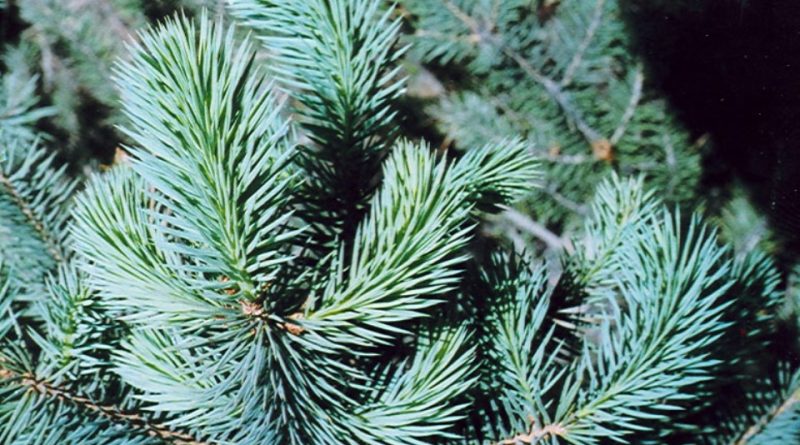Picea chihuahuana
Picea chihuahuana
The Chihuahua Spruce (Picea chihuahuana, Martínez, 1942) is an arboreal species belonging to the Pinaceae family.
Systematics –
From a systematic point of view it belongs to:
Eukaryota domain,
Kingdom Plantae,
Pinophyta division,
Class Pinopsida,
Pinales Order,
Pinaceae family,
Genus Picea,
Species P. chihuahuana.
Etymology –
The term picea is the Latin name of the wild pine in Virgil and Pliny and could, according to an etymological interpretation, derive from Pix picis = pitch, in reference to the abundant production of resin.
The specific name chihuahuana refers to Chihuahua, a Mexican state where this spruce mainly grows.
Geographic Distribution and Habitat –
The Picea chihuahuana is a species of spruce, rather rare, endemic and present in Mexico in the mountain area which is included between the states of Chihuahua, Durango and Nuevo León.
Its habitat in these areas is that of the slopes and gorges facing north, at altitudes between 2150 and 3200 m, on poor and sterile soils, but always humid, usually near perennial water sources; in the Sierra Madre Occidental it also grows on calcareous litosols.
It is a typical species of mixed forests, in association with other conifers (Pinus strobiformis, Pinus pseudostrobus, Pinus ayacahuite, Abies durangensis, Abies vejarii, Cupressus lusitanica, Cupressus arizonica and Pseudotsuga menziesii var. glauca), or with deciduous trees (Quercus castanea, Quercus rugosa and Prunus serotina.
Description –
Picea chihuahuana is a medium-sized evergreen conifer growing up to 25-35 m in height and with a trunk diameter of up to 1 m, with a conical crown, with widely spaced branches and hanging twigs.
The bark is thin and scaly, flaking off in small circular plates 5-10 cm in diameter.
The shoots are robust, light brown, glabrous and with prominent pulvini.
The leaves are needle-like, glaucous and opaque, slightly flattened and with a rhombic section, strongly pointed and almost thorny, 1.7-2.3 cm long; they have numerous bands of stomata.
The female cones are cylindrical, 7-12 cm long and 4-5 cm broad, initially green, then brown-orange when ripe. The macrosporophylls are 18-23 mm long and 14-20 mm broad, with almost squared tips.
The seeds are black, up to 4 mm long, with a 10-13 mm long tan wing.
Cultivation –
Picea chihuahuana is a conifer that was only discovered in 1942 by the Mexican botanist Maximino Martínez.
It is related to the Martinez fir of northeastern Mexico, but differs in shorter, blue-green leaves and smaller, narrower cones with smaller scales. No other related spruce is found in North America, with its closest relatives in East Asia.
As regards the minimum temperatures, it is resistant to cold between -12.1 °C and -6.7 °C.
From an aesthetic point of view it is a very attractive tree and is starting to be planted as an ornamental tree in the botanical gardens; it is particularly popular in warm areas as it is one of the more heat tolerant spruces, more tolerant of summer heat than Blue Spruce, which it resembles in foliage.
The optimal climate for growth is cool and humid, with annual rainfall between 800 and 1300 mm, largely the result of summer storms, except in the western part of the range where it rains also in winter; snow is present only at the highest elevations.
Propagation is by seed.
Customs and Traditions –
The Picea chihuahuana is a species that grows in small populations, present, approximately, between 2300 and 3200 m. asl. A 2000 inventory identified 39 populations in three disjointed clusters along the Sierra Madre Occidental, which extend northward for 687 km just south of the Tropic of Cancer.
A thorough study of the range shows that stands are almost invariably found on steep north-facing slopes. The central and southern populations are found at an average altitude of 2675 m, the northern ones at 2325 m.
Their native climate is continental and among the coldest in Mexico; in Creel, Chihuahua, temperatures range from an average minimum of -5.6 °C in January to an average maximum of 26.5 °C in July, with a summer-humid climate and average monthly rainfall of 16 mm in April and 166 mm in July.
Inventories to date have attempted to count and measure every living tree of the species. In 2000 Ledig et al. collected height, diameter, and vigor (presence of mistletoe, fire damage, and canopy dieback) metrics from 21 stands and merged their data with similar information collected by Narvaéz et al. (1983) for the other 18 stands, finding 42,610 trees higher than 0.3 m, of which 24,221 higher than 2 m. The data show an inverse J distribution indicative of fairly stable breeding populations.
This plant, given the extension of the distribution areas and the populations found, is classified as endangered as none of the populations includes more than a few hundred trees.
In Mexico, Picea chihuahuana is listed as threatened under the code: NOM-ECOL-059-94.
Method of Preparation –
The Picea chihuahuana is a relatively recently discovered plant and may have been used over time and by local populations, most likely, to obtain wood and fuel.
No alternative uses are known and, in any case, given its ecological condition of risk, it has been subjected to protection restrictions.
Guido Bissanti
Sources
– Acta Plantarum – Flora of the Italian Regions.
– Wikipedia, the free encyclopedia.
– GBIF, the Global Biodiversity Information Facility.
– Useful Tropical Plants Database.
– Conti F., Abbate G., Alessandrini A., Blasi C. (ed.), 2005. An annotated checklist of the Italian vascular flora, Palombi Editore.
– Pignatti S., 1982. Flora of Italy, Edagricole, Bologna.
– Treben M., 2000. Health from the Lord’s Pharmacy, Advice and experiences with medicinal herbs, Ennsthaler Editore.
Photo source:
– https://www.conifers.org/pi/pi/c/chihuahuana03.jpg
– https://quod.lib.umich.edu/cgi/i/image/api/image/herb00ic:1001809:MICH-V-1001809A/full/res:0/0/native.jpg
Attention: The pharmaceutical applications and alimurgical uses are indicated for informational purposes only, they do not in any way represent a medical prescription; we therefore decline all responsibility for their use for curative, aesthetic or food purposes.


